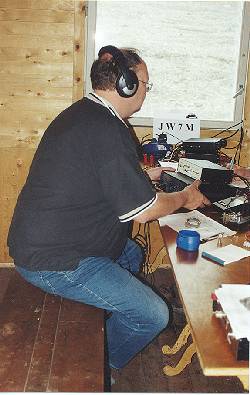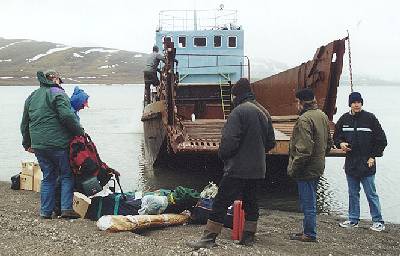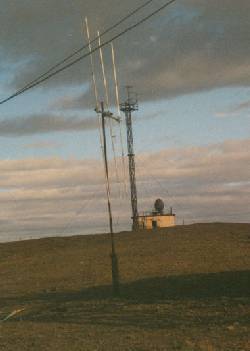In the middle of May, Hakan SM3EQY found a Site on Internet. LA7M was searching for crew members for a planned DXpedition to Svalbard. After a couple of mails between Sweden and Norway we decided to join this tour.
 Staffan,
SM3JGG listening on Six from the Ice Lake Cabin (JQ68)
Staffan,
SM3JGG listening on Six from the Ice Lake Cabin (JQ68)
On 6th July, it all started with a flight between Oslo and Longyearbyen on Spitsbergen, including a stop in Tromsö in the northern part of Norway. 12 amateurs with a lot of equipment, including aluminium towers because there are no trees that could bear the antennas. Our part of the group had to spend some hours in Longyearbyen waiting for the rest of the team, it was really exotic to see people walking around in the village carrying big guns on their shoulders - they are necessary for protection against polar bears.
When the whole group had arrived, it was time for a 3.5-hour journey with a Russian tug to Barentsburg, a Russian coalmining town with about 1000 inhabitants. All of them work for the Russian mining company, an carry out many tasks including taking care of the guests in the Hotel and running a farm with 20 cows, a bull, 300 pigs and about 1000 hens. There is also a greenhouse with different vegetables like tomatoes and potatoes. The inhabitants get free food and housing during their stay, and hopefully get their pay checks from the mining company then whey arrive back home after a couple of years.
After our arrival we put all our stuff and our selves into the ‘HOTEL Barentsburg’ a nice hotel built about 30 years ago. All rooms have toilet and shower, and the bar has good Russian beers and also beers bottled in Western Europe.
LA3OHA, Terje had already prepared a shack on a mountain close to the hotel. 300m ASL, this mountain slopes down to Greenfjord/Icefjord. A marvellous QTH with a good take off in all directions, except towards the southeast. A TH6DXX was placed on a tower at the old TV-station, our radio shack during our stay.
 Landing
equipment on the beach close to the Ice Lake Cabin.
Landing
equipment on the beach close to the Ice Lake Cabin.
With so many operators available, we decided to split the group into two. The main group stayed in Barentsburg and a smaller group went with an old boat to a Russian Cabin in the arctic wilderness. A really marvellous place, close to a little lake, with a glacier at one end and a cabin at the other end. After a hard time carrying all ouir stuff to the cabin (rig, antennas, towers, battery, petrol, generator and some food), it was time to assemble the station. A half-square for 20 metres was put up in the air between the cabin and one of the towers in no time at all.
Geoffrey, KGØVL had to spend many hours before he managed to get the power generator working okay. I think it was trouble with the Russian petrol that we got from one of the cars in Barentsburg. At last it was time to start the operation from Icelake. In a few minutes, two 220 volt 25 amps power-supplies were blown up, together with the power supply to the computer. The generator probably delivered about 300 V instead of 220 V (of course we had not brought a simple voltmeter).
Without logging computer or power-supplies, we had to operate from a single battery and try to keep it in good shape with a 10 amp battery charger. It was so hot that we had to keep it outside when we ran it on the 300 V from the generator.
Next day Jasek SP5DRH assemble a mini beam for 10/15/20 metres, which was almost as good as the half-square antenna. Geoffrey had put up a 50 MHz dipole outside the cabin and we listened on Six during the evening and nights. The only signal heard on Six from Icelake was the VE8BY beacon for a few minutes one night.
The group managed to work about 850 QSOs on 20 and 17 metres from the Icelake cabin, which must be OK considering all the equipment problems we had in the beginning.
During our stay in the marvellous wilderness, the expedition’s main station had spent a lot of time making QSOs from the mountain-top QTH outside Barentsburg and had also spent a lot of energy climbing the mountain up to the station. It was 700 steps: Dave (KF6XA) counted them during one of his many tours. Hakan, SM3EQY spent a lot of time on 50 MHz calling and looking for conditions without any QSOs so far.
When the wilderness group came back to Barentsburg, we arranged a second station at the hotel with the half square antenna on the roof.
 The
50 MHz antenna on the mountain QTH in Barentsburg. We tried vertical
polarisation because of QRM from a TV station about 300 metres away.
The
50 MHz antenna on the mountain QTH in Barentsburg. We tried vertical
polarisation because of QRM from a TV station about 300 metres away.
On Tuesday night (11th July) an Auroral-E opening to Scandinavia gave us some QSOs on 50 MHz. The OH9SIX and SK3SIX beacons were heard and OH6JW, OH8K, SM3GSK, OH7KM, SM3VEE, OH6MPC, OH1AYQ, SM3EFW and OH1ZAA were worked. After that we could hear the VE8BY beacon for about 1.5 hours, but without any QSOs to North America.
Thursday 13th of July was time for the journey home, firstly by a Russian tug to Longyearbyen, then a flight to Oslo, and then by car for 420 km, a total of 36 hours.
We were operational for five days, with a total of 7700 QSOs from a QTH at 78 North, most of them with the call JW7M.
And naturally we had the pleasure of meeting all the team members from different places in the world. Almost all the members of the crew were surprised that we made any QSOs at all on Six. I am sure that we will meet some of them on the magic band in the future.
Expedition Homepage: http://www.dxpedition.org
Expedition Logs: http://www.xdenews.net/logs/svalbard/